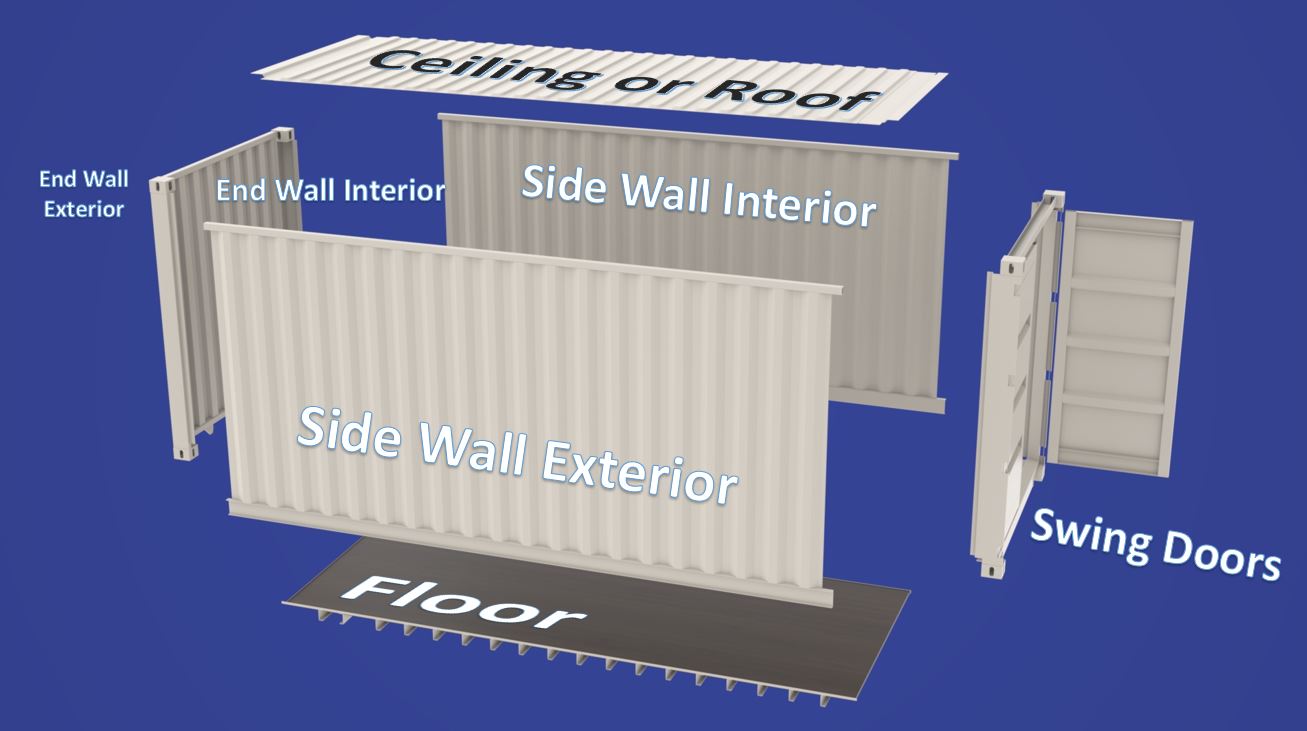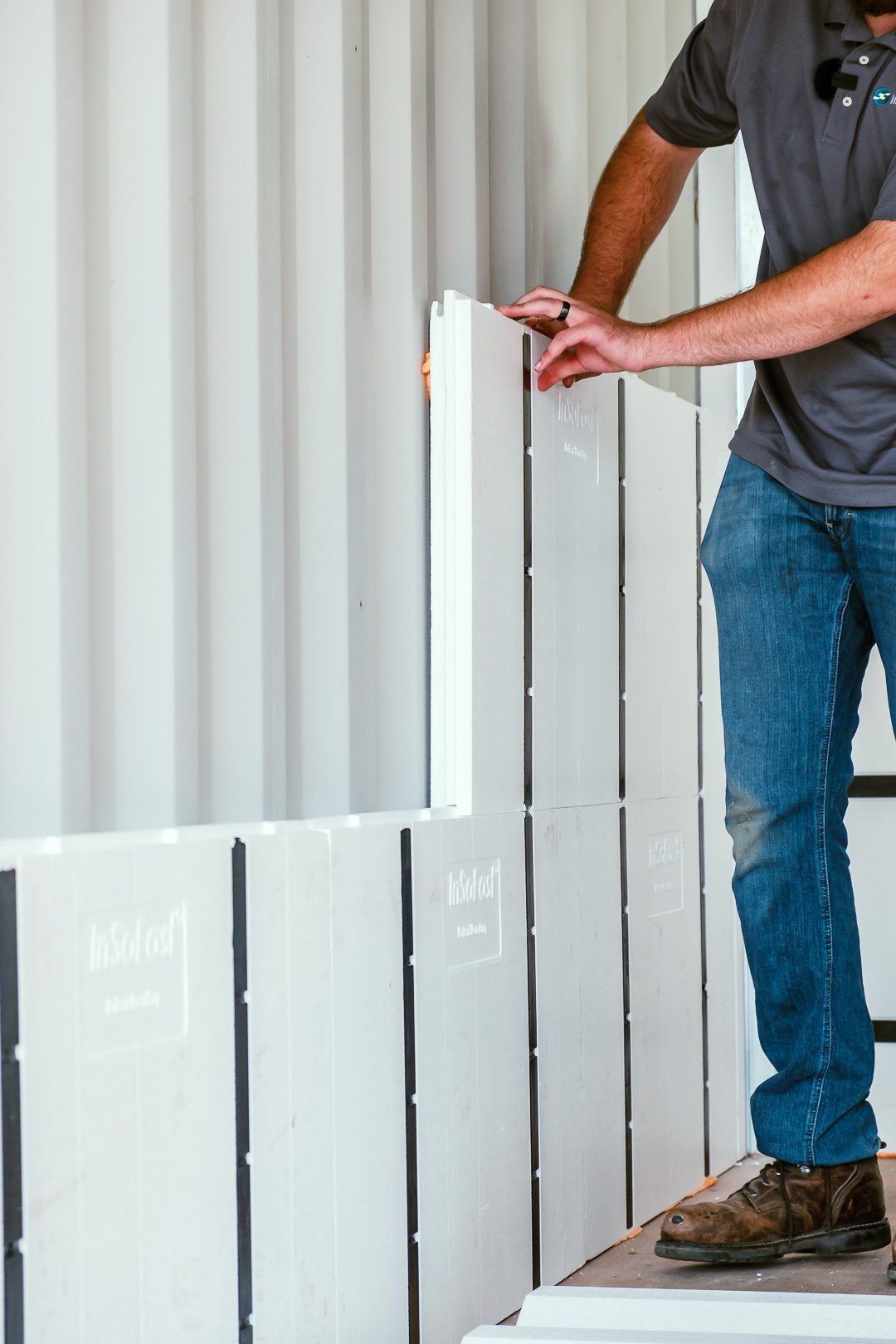Sidewall (20' Standard) CX44-Bundle – View Product >Price: $ 730.00
This CX44 bundle assembly has enough material to finish one 20' standard container 8' side wall. The studs are 22 inches on center.
20' Standard 8' Sidewall Bundle - (CX44 -5 Boxes of 5 Panels)
(CX44 Insulated Panels = 25 panels) = 183 sq-ft.
Part Code: CONSWCX-5
Sidewall (20' High Cube) CX44-Bundle – View Product >Price: $ 730.00
This CX44 bundle assembly has enough material to finish one 20' High Cube Container side wall. The studs are 22 inches on center.
20' High Cube Sidewall Bundle - (CX44 -5 Boxes of 5 Panels)
(CX44 Insulated Panels = 25 panels) = 183 sq-ft.
SKU: CONSWCX-5
Sidewall (40' Standard) CX44-Bundle – View Product >Price: $ 1,314.00
This CX44 bundle assembly has enough material to finish one 40' standard container 8' side wall. The studs are 22 inches on center.
40' Standard 8' Sidewall Bundle - (CX44-9 Boxes of 5 Panels )
(CX44 Insulated Panels = 45 panels) = 330 sq.ftPart Code: CONSWCX-9
Sidewall (40' High Cube) CX44-Bundle – View Product >Price: $ 1,460.00
This CX44 bundle assembly has enough material to finish one 40' High Cube container side wall. The studs are 22 inches on center.
40 ' HC Side Wall Bundle - (CX44 -10 Boxes of 5 Panels )
(CX44 Insulated Panels = 50 panels) = 367 sq.ft
Sidewall (20' Standard) 2.0 Flat Panel-Bundle – View Product >Price: $ 732.00
Sidewall bundle for one side wall
This bundle contains:
2 (I-SWI) Side Wall Insert = 60 pcs.
4 (FP-2.0RW) 2" Flat Panel with raceways (5 panels/box) = 160 Sq.Ft.
SKU: CON-SWUX-20ST
Sidewall (20' High Cube) 2.0 Flat Panel-Bundle – View Product >Price: $ 860.00
Sidewall bundle has material to finish one sidewall
This bundle contains:
2(I-SWI) Side Wall Insert = 60 pcs
5 (FP-2.0RW) 2" Flat Panel with raceways (5 panels/box) = 200 Sq.Ft.
SKU: CON-SWUX-20HC
Sidewall (40′ High Cube) 2.0 Flat Panel-Bundle – View Product >Price: $ 1,592.00
Sidewall bundle for one side wall
This bundle contains:
4 (I-SWI) Side Wall Insert = 120 pcs.
9 (FP-2.0RW) 2" Flat Panel with raceways (5 panels/box) = 360 Sq-ft.
SKU: CON-SWUX-40HC
Sidewall (40' Standard) 2.0 Flat Panel-Bundle – View Product >Price: $ 1,354.00
Sidewall bundle has material to finish one side wall
This bundle contains:
3 (I-SWI) Side Wall Insert = 90 pcs.
8 (FP-2.0RW) 2" Flat Panel with raceways (5 panels/box) = 320 Sq.Ft.
SKU: CON-SWUX-40ST
Endwall (Container) 2.0 Flat Panel-Bundle – View Product >Price: $ 346.00
End Wall High Cube bundle is part of an assembly with enough material to finish the end wall of a High Cube container wall using the End Wall Inserts and a Flat 2.0 panels with studs.
This bundle contains:
1 (I-EWI) End Wall Insert Box = 20 pcs. 2 (FP-2.0) 2.0" Flat Panel = 10 panels (5 panels/box) = 80 Sq.Ft.
SKU: CON-EW
Ceiling (20’ Container) 2.0 Flat Panel-Bundle – View Product >Price: $ 604.00
Ceiling Insert bundle (CONCEIL-20 ) is part of an assembly with enough material to finish the ceiling of a 20′ container.
This bundle contains:
1 Boxes (CCEIL Inserts 57 pcs.) 4 Boxes (FP-2.0 Panels 5 each box ) = 160 sq-ft. SKU: CONCEIL-20
Ceiling (40’ Container) 2.0 Flat Panel-Bundle – View Product >Price: $ 1,208.00
Ceiling Insert bundle is part of an assembly with enough material to finish the ceiling of a 40′ container.
This bundle contains:
2 Boxes (CCEIL Inserts 57 pcs.) = 114 pcs. 8 Boxes (FP-2.0RW Panels 5 each box ) = 320 sq-ft. SKU: CON-CEIL-40
Floor (20’ Container) 2.0 Flat Panel-Bundle – View Product >Price: $ 512.00
The (FP-2.0) 2.0″ Flat Panel is versatile solution for container insulated sub-flooring.
This bundle contains:
4 (FP-2.0) 2.0″ Flat Panel = 20 panels (5 panels/box) = 160 sq-ft.
SKU: CON-FLOOR-20
Floor (40’ Container) 2.0 Flat Panel-Bundle – View Product >Price: $ 1,024.00
The (FP-2.0RW) 2.0″ Flat Panel is versatile solution for container insulated sub-flooring.
This bundle contains:
8 (FP-2.0RW) 2.0″ Flat Panel = 40 panels (5 panels/box) = 320 sq-ft.
SKU: CON-FLOOR-40
Swing Doors (Container) Flat Bundle – View Product >Price: $ 138.00
EX2.5 (FP-2.5) Panels for Doors
You need a minimum of 4-5 panels per door depending on the height of the container. Adjust your quantity to display the number of doors you need to cover, approximately 1 box per door.
Add On Door Option 1 box (Per Door)
Corner Post Endwall Standard-Bundle – View Product >Price: $ 167.00
Corner Post Insert is a 3 part per assembly for the inside corner end wall of a standard container.
End Wall Corner Inserts contains:
8 pcs of custom shaped foam inserts - 45 1/4in long x 2in thick.
4 Metal "M" Angle Inserts – 45 1/4in long x 1 3/4 in wide legs
Corner Post Endwall High Cube-Bundle – View Product >Price: $ 207.00
Corner Post Insert is a 3 part per assembly for the inside corner end wall with Add-On extensions for High Cube Containers.
End Wall Corner Inserts contains:
8 pcs of custom shaped foam inserts - 45 1/4in long
4 pcs of custom shaped foam inserts - 12 1/4in long
4 Metal "M" Angle Inserts – 45 1/4in long x 1 3/4 in wide legs
SKU: CON-EWCP-HC SKU: CON-EWCP-ST (Order Standard)



